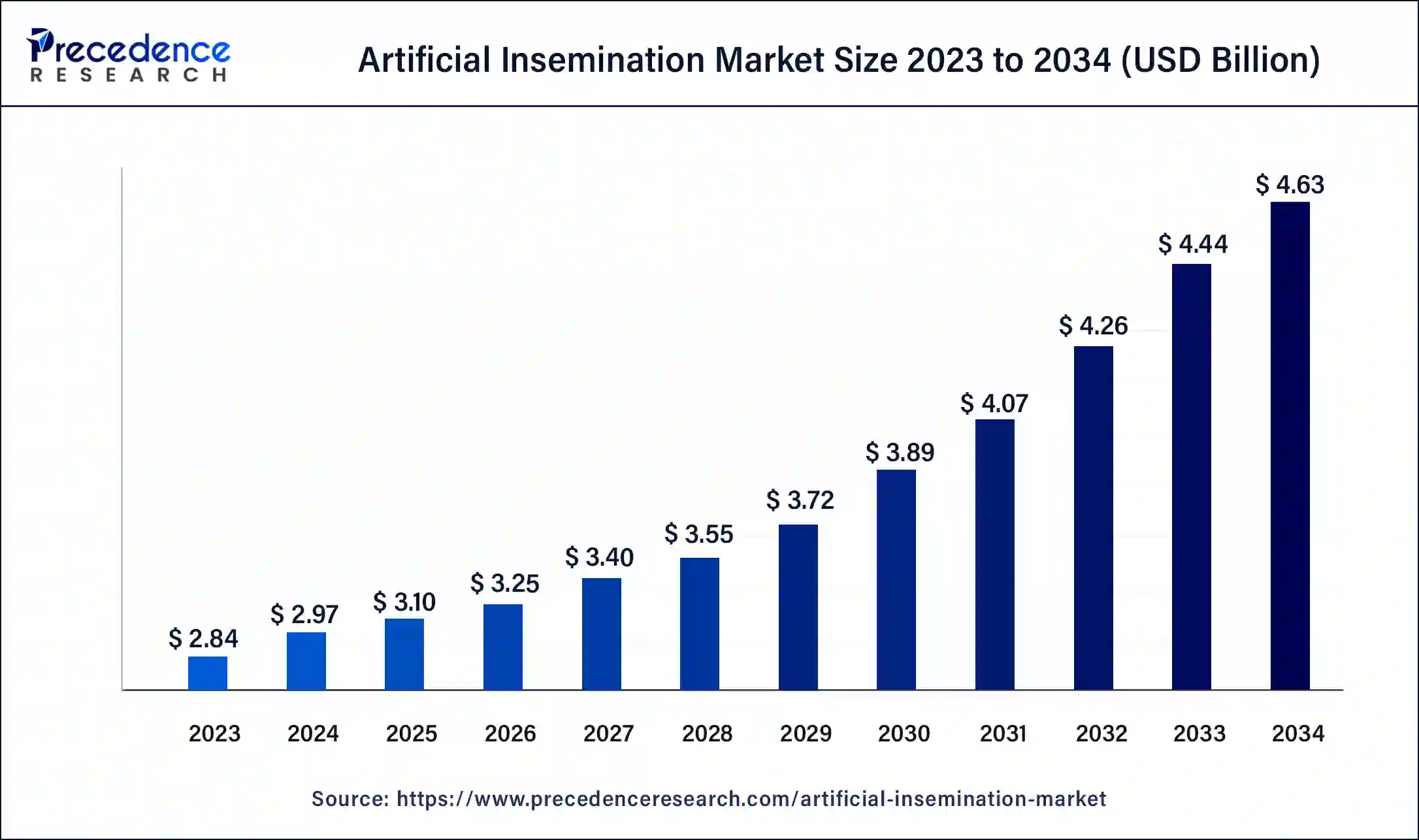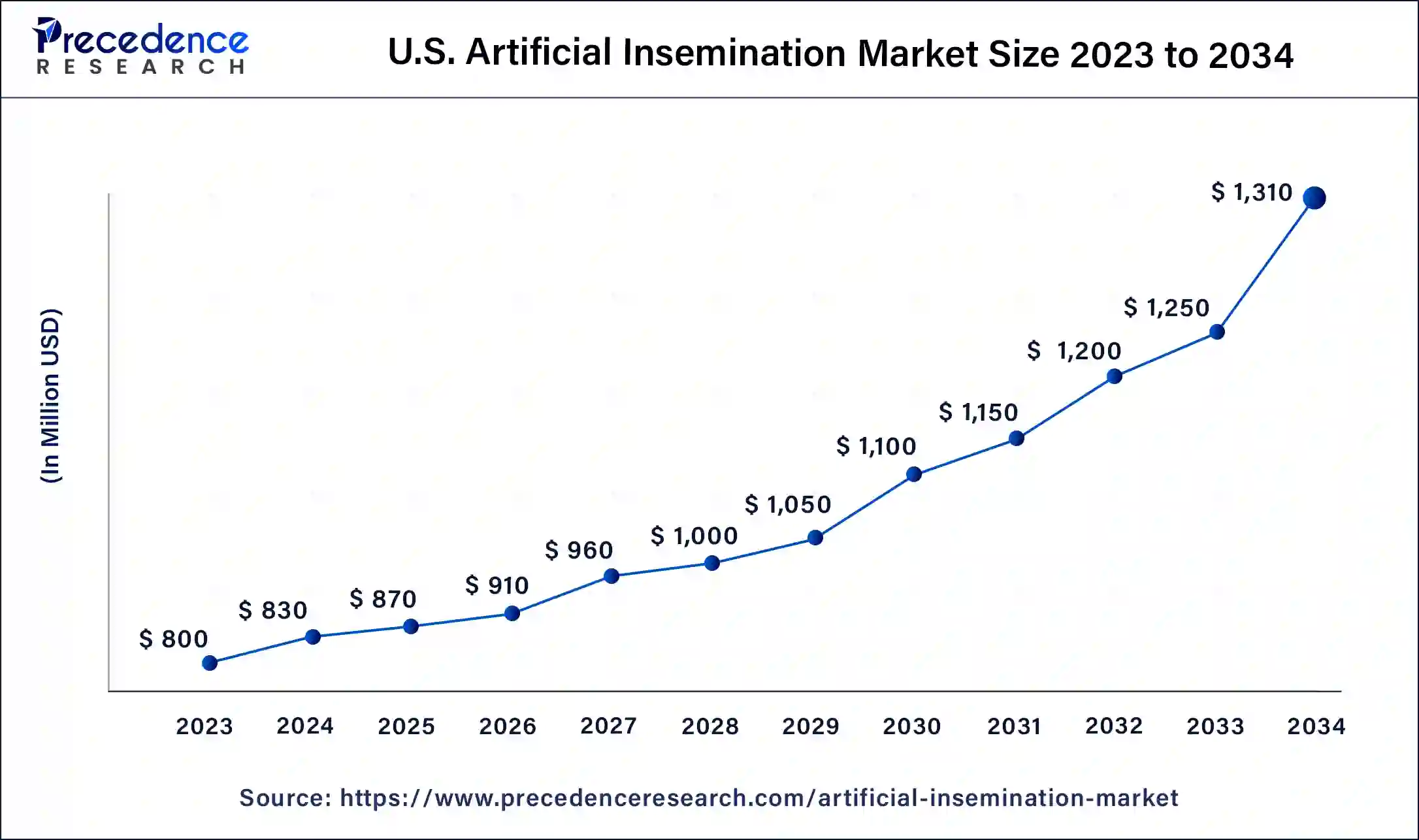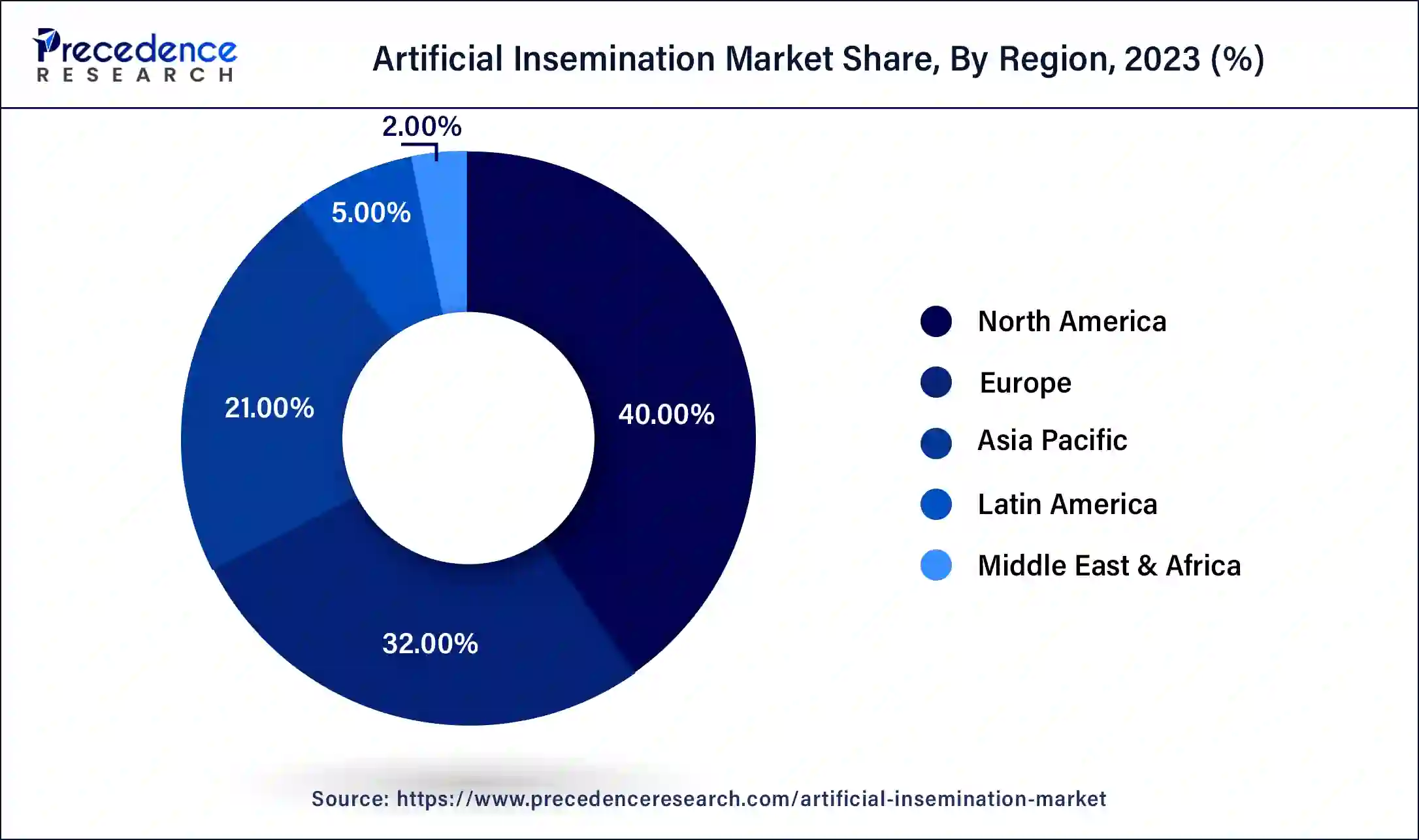August 2024
The global artificial insemination Market size was USD 2.84 billion in 2023, estimated at USD 2.97 billion in 2024 and is anticipated to reach around USD 4.63 billion by 2034, expanding at a CAGR of 4.54% from 2024 to 2034.
The global artificial insemination market size accounted for USD 2.97 billion in 2024 and is predicted to reach around USD 4.63 billion by 2034, growing at a CAGR of 4.54% from 2024 to 2034. The North America artificial insemination market size reached USD 1.14 billion in 2023.

The U.S. artificial insemination market size was valued at USD 800 billion in 2023 and is expected to be worth USD 1310 billion by 2032, growing at a CAGR of 4.67% from 2024 to 2034.

North America dominated the market in 2023 due to the high healthcare spending and the growing awareness about fertility treatments. The U.S. and Canada are the main contributors to this market. North America has a robust healthcare infrastructure with advanced technologies. Moreover, the presence of major market players and stringent rules and regulations is anticipated to fuel the market growth shortly.
The Asia-Pacific market is projected to have the highest growth rate during the forecast period. This is due to factors such as rising disposable income, increased awareness of fertility treatments, and the availability of advanced reproductive technologies in the region.

Europe is the second-largest market for artificial insemination, with a growing demand for fertility treatments. This is driven by an increase in infertility cases and advancements in reproductive technology.
Latin America, the Middle East, and Africa have a lower adoption rate of artificial insemination. However, the market is expected to grow in these regions due to increasing awareness, improvements in healthcare infrastructure, and government initiatives to promote fertility treatments.
The artificial insemination (AI) market has been steadily growing and gaining popularity in various regions. AI is a reproductive technology used in both human and animal reproduction, and its adoption has been increasing due to its numerous advantages, such as improved conception rates, disease control, and preservation of genetic diversity.
In the human artificial insemination market, there has been a rising demand for assisted reproductive technologies. This is driven by factors such as delayed pregnancies, infertility issues, and same-sex couples seeking to start families. The market has expanded due to technological advancements in artificial insemination procedures, as well as increased awareness and acceptance of these methods. There are different techniques for AI, including intrauterine insemination (IUI) and in vitro fertilization (IVF). AI is a popular and effective fertility treatment option, especially because donor sperm is readily available.
The growing awareness and acceptance of artificial insemination as a mainstream fertility treatment is likely to contribute to market expansion. Advancements in reproductive technologies have improved the success rates of artificial insemination procedures, which can fuel the market. Moreover, the increasing infertility issues due to lifestyle changes are expected to fuel the market in the coming years. For instance,
The growing awareness and acceptance of artificial insemination as a mainstream fertility treatment is likely to contribute to market expansion. Advancements in reproductive technologies have improved the success rates of artificial insemination procedures, which can fuel the market. Moreover, the increasing infertility issues due to lifestyle changes are expected to fuel the market in the coming years. For instance,
| Report Coverage | Details |
| Market Size in 2023 | USD 2.84 Billion |
| Market Size in 2024 | USD 2.97 Billion |
| Market Size by 2034 | USD 4.63 Billion |
| Growth Rate from 2024 to 2034 | CAGR of 4.54% |
| Largest Market | North America |
| Base Year | 2023 |
| Forecast Period | 2024 To 2034 |
| Segments Covered | Type, Product Type, and Region |
| Regions Covered | North America, Europe, Asia-Pacific, Latin America, and Middle East & Africa |
Rising infertility rates
According to a recent report published by the World Health Organization (WHO) in April 2023, a significant number of individuals experience infertility at some point in their lives. Approximately 17.5% of the global adult population, which is roughly 1 in 6 people worldwide, are affected by this issue. Infertility is a widespread issue that affects millions of people around the world who are of reproductive age. According to available data, approximately one in six individuals globally experience infertility at some point in their lives.
Infertility is a medical condition that occurs when a person is unable to achieve pregnancy after trying for 12 months or more without using any contraception. There are two types of infertility are primary infertility, which refers to the inability to conceive at all, and secondary infertility, which is the inability to conceive after previously having a successful pregnancy. The World Health Organization's International Classification of Diseases provides detailed information on the various causes of infertility in both men and women.
The demand for artificial insemination has been increasing in recent decades due to the rising prevalence of infertility worldwide. Infertility can be caused by factors related to either the male or female reproductive system, a combination of both or it may be unexplained. Infertility is a significant health concern affecting both men and women. The artificial insemination market has been growing significantly due to various factors. Several factors contribute to this trend, including lifestyle changes, environmental factors and the decision to delay pregnancies for career or personal reasons. Modern lifestyles characterized by stress, sedentary habits, and unhealthy diets have been linked to reproductive issues, making it difficult for couples to conceive naturally. Environmental factors, such as exposure to pollutants and toxins, also affect reproductive health. Moreover, the trend of delaying childbirth, especially in developed countries, has led to a higher incidence of age-related infertility.
As women age, their fertility decreases, making it significantly harder to conceive naturally. These challenges have led individuals and couples facing fertility issues to seek alternative methods to achieve pregnancy, leading to an increased demand for assisted reproductive technologies like AI. Artificial insemination provides a safe, effective, and controlled approach to overcome various infertility problems. It involves directly introducing sperm into the female reproductive tract, increasing the chances of fertilization and successful conception. Advancements in AI techniques, such as intrauterine insemination (IUI) and in vitro fertilization (IVF), have further improved success rates, making AI a preferred choice for individuals seeking to start a family. Additionally, the growing awareness and acceptance of assisted reproductive technologies have reduced the stigma associated with seeking fertility treatments, encouraging more people to consider AI as a viable option for parenthood.
Ethical and legal issues
Artificial Insemination (AI) is faced with significant ethical and legal considerations that hinder its widespread adoption in human and animal reproduction. Ethical concerns arise from different cultural, religious, and philosophical viewpoints on conception and the use of assisted reproductive technologies. In the context of human artificial insemination, some individuals and couples may have moral or religious objections to manipulating the natural reproductive process. The idea of conception occurring outside the traditional context of a natural union can raise ethical dilemmas for certain communities. Additionally, concerns about selecting desirable genetic traits through artificial insemination procedures may raise ethical questions about eugenics and its impact on society.
The legal issues surrounding artificial insemination can be complex and vary from country to country. Regulations regarding assisted reproductive technologies including artificial insemination can differ significantly with some regions having strict guidelines and others having more permissive laws. Legal uncertainties may affect the availability and accessibility of artificial insemination services and may even lead individuals to seek this treatment in countries with more favourable legal environments which resulting in cross-border fertility tourism. Another ethical aspect is related to the use of donor gametes (sperm or eggs) in artificial insemination procedures. Questions about identity disclosure, the right of offspring to know their genetic heritage and potential implications for family dynamics can create ethical dilemmas for both donors and recipients. Addressing these ethical and legal issues requires transparent communication between healthcare providers and patients.
Technology advancement
Technological advancements have been at the forefront of driving significant improvements in the field of assisted reproductive technologies, providing promising opportunities to enhance the effectiveness and success rates of artificial insemination (AI) procedures. Researchers and scientists have been relentlessly exploring new methods and refining existing techniques to optimize the entire AI process, from sperm preparation to fertilization. One critical area of focus is sperm selection, as the quality of the sperm directly impacts the success of AI. Advanced sperm selection techniques, such as sperm sorting based on morphology, motility, and DNA integrity enable the identification and use of the highest-quality sperm for insemination. This targeted approach enhances the likelihood of successful fertilization and improves the overall efficiency of AI treatments.
Cryopreservation techniques have made significant progress, resulting in improved preservation and storage of both sperm and eggs. This advancement ensures that viable gametes are available when needed, offering more flexibility in the timing of artificial insemination procedures and potentially reducing the need for multiple cycles. Genetic testing has also transformed the artificial insemination market, with pre-implantation genetic testing (PGT) being a prominent example. PGT allows for the examination of embryos for specific genetic disorders before implantation, reducing the risk of passing on hereditary diseases to offspring and increasing the chances of a successful pregnancy. The advancements in laboratory equipment and culture media have created optimized environments for sperm and embryo development. These improvements provide better conditions for successful fertilization and embryo implantation.
Impact of COVID-19:
The COVID-19 pandemic had a significant impact on the artificial insemination (AI) market, both before and after the outbreak. Prior to the pandemic, the AI market was growing steadily due to factors such as increasing infertility rates, advancements in reproductive technologies, and greater awareness and acceptance of assisted reproductive services. Both the human and animal AI segments were experiencing increased demand, with several key regions contributing to the market's expansion.
The outbreak of COVID-19 in early 2020 caused widespread disruptions across industries, including healthcare and agriculture, which in turn affected the AI market. During the initial phase of the pandemic, many countries implemented strict lockdowns and social distancing measures, resulting in the closure of fertility clinics and restrictions on non-essential medical procedures, including certain AI treatments. As a result, there was a temporary decline in the number of AI procedures performed, particularly in the human reproduction sector. Additionally, the economic uncertainties brought about by the pandemic put financial strain on individuals and households, causing some people to delay or reconsider their fertility treatment plans. This had an impact on the demand for AI services. However, as the pandemic continued, the AI market showed resilience and adaptability. Fertility clinics and healthcare providers implemented safety protocols and telemedicine solutions to gradually resume AI procedures.
In the animal AI market, the agriculture sector adjusted to the changing circumstances by adopting new strategies for livestock breeding and genetic improvement. Furthermore, as the pandemic increased awareness of health and hygiene, some individuals and livestock breeders may have developed a renewed interest in AI as a way to mitigate potential health risks associated with natural breeding.
The intrauterine insemination segment led the market in 2023. The artificial insemination (AI) market is often divided into different categories based on the techniques used for insemination. These techniques provide various ways to introduce sperm into the female reproductive tract and cater to different fertility needs. The three main types of AI techniques are as follows:
The intracervical insemination segment is anticipated grow rapidly during the forecast period. insemination (IUI) technique involves directly placing prepared sperm into the woman's uterus. By bypassing the cervix and entering the uterine cavity, this method increases the chances of sperm reaching the fallopian tubes for fertilization. IUI is commonly used in cases of unexplained infertility, mild male factor infertility, and when the woman has cervical issues that may hinder sperm from passing through the cervix.
Intracervical insemination (ICI) technique involves placing sperm near the cervix without directly entering the uterine cavity. It is a less invasive alternative to IUI and is often used when IUI is not feasible or appropriate. ICI can sometimes be performed at home using specially designed kits for self-insemination.
The intravaginal insemination technique involves introducing sperm into the vaginal canal, allowing it to naturally travel through the cervix and into the uterus. It is the least invasive method and is commonly used for home insemination. However, its success rates may be lower compared to IUI and ICI, as it relies on sperm navigating through the reproductive tract on their own. Each type of AI technique has its own advantages and may be recommended based on individual fertility factors, cost considerations, and medical guidance. In assisted reproductive clinics, healthcare professionals assess the couple's medical history, diagnostic tests, and specific fertility needs to determine the most appropriate AI method.
In 2023, the insemination kits segment dominated the market. The AI market can be divided into different product types, each designed to facilitate different AI procedures. The main product types in the AI market are insemination kit, home conception devices, accessories.
An insemination kit includes all the necessary components and equipment needed to perform the AI procedure. These kits are used by healthcare professionals in fertility clinics and assisted reproductive technology centers. The kit typically contains items such as catheters, syringes, speculums, and other sterile instruments needed to deliver sperm into the reproductive tract.
The home conception devices segment is expected to expand rapidly in the coming years. Home conception devices are a newer addition to the AI market. These devices allow individuals or couples to perform certain AI procedures at home. They come with user-friendly instructions and pre-packaged components, making it easier for individuals to self-administer the insemination process without medical assistance.
AI accessories include a wide range of products that complement the AI procedure. These may include ovulation predictor kits, fertility-friendly lubricants, pregnancy tests, and sperm preparation media. Accessories play a supportive role in ensuring the best conditions for successful AI outcomes.
The availability of different product types caters to the varying needs and preferences of patients as well as the diversification of the AI market. Insemination kits are essential for medical professionals to perform AI procedures in clinical settings with precision and sterility.
The fertility clinics segment dominated the market in 2023, accounting for major market share. The segment growth is attributed to the increasing number of medical centers providing infertility treatment and the increasing global infertility rates. Furthermore, insemination procedures at clinics include consultation and fixation of the ovulation cycle before starting the procedures.
Segments Covered in the Report:
By Type
By Product Type
By Geography
For inquiries regarding discounts, bulk purchases, or customization requests, please contact us at sales@precedenceresearch.com
No cookie-cutter, only authentic analysis – take the 1st step to become a Precedence Research client
August 2024
December 2024
September 2024
April 2025